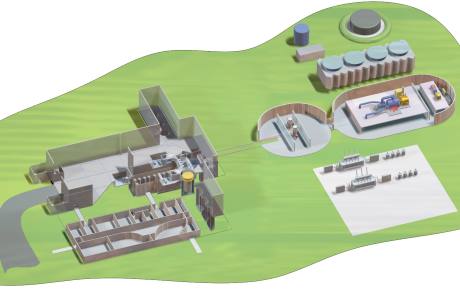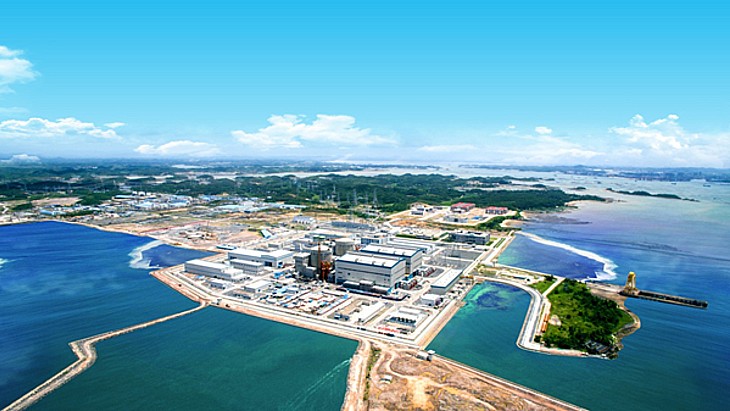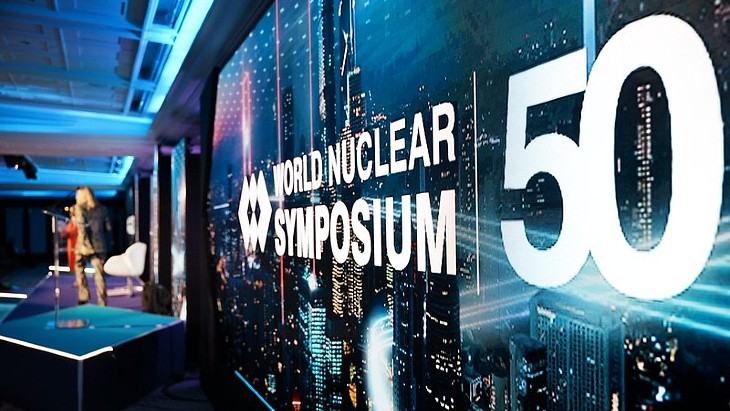The Canadian Nuclear Safety Commission (CNSC) has completed the first phase of a vendor design review of Terrestrial Energy Inc's Integrated Molten Salt Reactor (IMSR). The design is the first advanced reactor to complete the first phase of the CNSC's regulatory pre-licensing review.
 |
| An IMSR facility (Image: Terrestrial Energy/CC-BY-SA) |
The vendor design review provides an opportunity for CNSC staff to assess a design prior to any licensing activities, enabling the vendor to identify potential issues that would require resolution. Phase 1 of the review determines whether the vendor is demonstrating intent to be compliant with CNSC requirements in its design processes and outcomes.
The CNSC announced yesterday that, based on the documentation submitted by Terrestrial Energy, the company had demonstrated an understanding of the regulator's requirements applicable to the design and safety analysis of the 400 MWt IMSR, known as IMSR400. The company has also demonstrated its intent to comply with CNSC regulatory requirements and expectations for NPPs, and is integrating Fukushima lessons learned into IMSR design provisions, the regulator said.
Terrestrial Energy will need to undertake additional work to address some of the review's findings, including the need to establish robust quality-assured processes for design and safety analysis activities, the CNSC said.
Issues that will require follow-up work include a need for additional evidence to show Terrestrial Energy has in place a "documented systematic process" to support its design activities. While the CNSC acknowledges the company is working towards establishing quality-assured processes for design and safety analysis activities, many overarching design process documents, such as safety design guides and safety specification documents, are still under development, it said. It expects Terrestrial Energy, in the second phase of the review, to demonstrate it has established sufficient systematic processes in its management system to support its ongoing development activities.
Several features are currently at the conceptual level of design and will require additional technical information, based on research and development and design activities, the CNSC said, while some design features will need further consideration because of the novel design of the IMSR400.
Further work will be needed to predict core behaviour in the presence of damaged core components - although the CNSC acknowledges that the definition of core damage as set out in current regulations, which were drawn up based on operating experience from water-cooled reactors, may not be applicable to the IMSR design. Terrestrial Energy will also be required to complete further safety analysis work relating to core damage, and to provide further information on how it will validate predictions of performance as the reactor ages.
In the second phase of the review, Terrestrial Energy will also be required to demonstrate that human factors in design have been appropriately addressed in its operability and maintainability programs, which are currently under development.
"Notwithstanding the above, these finding are resolvable and will be followed up in future VDRs [vendor design reviews]," the CNSC said.
Terrestrial Energy CEO Simon Irish said: "Completing phase 1 of the vendor design review - the first advanced reactor to do so - is a landmark achievement. It places the company as an early leader in a fast growing technology sector. The IMSR nuclear power plant is a transformative energy technology that is now one step closer to making a major contribution to the world’s growing demand for low-cost, clean and reliable energy."
Molten salt reactors use fuel dissolved in a molten fluoride or chloride salt which functions as both the reactor's fuel and its coolant. This means that such a reactor could not suffer from a loss of coolant leading to a meltdown. Terrestrial's IMSR integrates the primary reactor components, including primary heat exchangers, to a secondary clean salt circuit, in a sealed and replaceable core vessel. It is designed as a modular reactor for factory fabrication, and could be used for electricity production and industrial process heat generation.
Earlier this year, Terrestrial Energy began a feasibility study for the siting of the first commercial IMSR at Canadian Nuclear Laboratories' (CNL) Chalk River site. It has also said it intends to submit an application to the US Nuclear Regulatory Commission for a design certification or construction permit in late 2019.
The CNSC's pre-licensing vendor design review is an optional service to provide an assessment of a nuclear power plant design based on a vendor's reactor technology. It is not a required part of the licensing process for a new nuclear power plant, but aims to verify the acceptability of a design with respect to Canadian nuclear regulatory requirements and expectations.
The review involves three phases: a pre-licensing assessment of compliance with regulatory requirements; an assessment of any potential fundamental barriers to licensing; and a follow-up phase allowing the vendor to respond to findings from the second phase. These findings will be taken into account in any subsequent construction licence application, increasing the efficiency of technical reviews, according to the CNSC.
Researched and written
by World Nuclear News




_92619.jpg)
_84504.jpg)

_58447.jpg)




